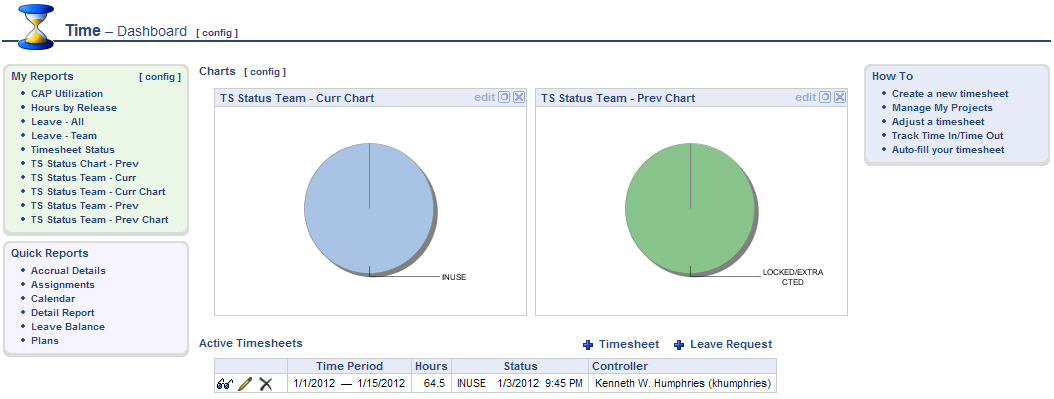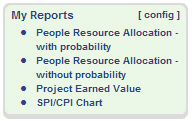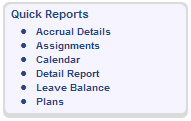|
|
|
|
The Time Dashboard provides a number of navigational links, summary information, helpful tips and more. Below is an example dashboard screen with a description of the various items that may be included.
This dashboard is available to users having any of the following roles: Timesheet User, UnaSource User (and their alternates). The sections and options that may appear depend on which roles a user has.
This dashboard is available with any of the following Unanet licenses: Project Time, Project Tracking, Project Portfolio, Project Tracking Financials and Project Portfolio Financials.
Topics covered on this help page include:
Sub-Menu Items (on the main menu)
Timesheet Add (adding a new timesheet)
Leave Request Add (adding a request for leave)
You may also be interested in:
Auto-fill Timesheets (auto-populate last period's projects on current timesheet)
CA Overtime Rules - Quick Topic - Best Practices for Handling Time and a half Overtime and Double Time in Unanet

Depending on each user's roles, the following sub-menu items may be available under the Time main menu item:

List -- Selecting this menu option will present the user with a list of their Active and Historical timesheets.
Current -- Selecting this menu option will directly jump the user to their current timesheet (that is, an existing timesheet for the current date). If no timesheet exists for the current date, then the user will be directed to the Timesheet Add screen.
Plan -- Selecting this menu option will present the user with a list of their current planned work entries, where they can review and create additional planning entries.
ETC -- Selecting this menu option will present the user with a search/list screen for viewing and updating assignment ETC values.
My Projects -- Can be used to manage which Projects/Task will show up on the user's timesheet or expense report.
Clicking on the [config] link to the right of the Dashboard title, is a short cut to the Preferences >> Dashboard (Dashboards tab) where you can manage which sections will appear on the various dashboards.
If you have a certain report that you run on a frequent basis with the same or similar selection criteria, you can save and reuse that criteria. Once you save a report or create an ad-hoc report, you can control which saved reports and/or ad-hoc reports will appear in your My Reports section so that you can quickly run the report directly from your dashboard (without having to supply selection criteria).
Clicking on the [config] link is a short cut to the Preferences >> Dashboard (My Reports tab) where you can manage which Saved Reports and/or Ad-hoc Reports will appear in your My Reports listing. Note that you can control which saved reports will appear on each of the main menu dashboard. An example appears below:

Check out Saving Report Criteria and Adhoc Reporting for more information regarding those topics.
Similar to the concept of My Reports, Administrators can define saved reports and make them available for others to run.
Clicking on the [config] link in this section is a short cut to the Preferences >> Dashboard (Shared Reports tab) where you can manage which Saved Shared Reports will appear in your Shared Reports listing. Note that you can control which shared reports will appear on each of the main menu dashboard. An example appears below:

Administrators can check out Sharing Reports for more information.
Similar to the concept of My Reports, users can define saved selection criteria for various lists for one click running (such as lists of people, list of projects, and even Project Notes selection criteria).
Clicking on the [config] link in this section is a short cut to the Preferences >> Dashboard (My Lists tab) where you can manage which My List lists will appear in your My Lists listing. Note that you can control which saved lists will appear on each of the main menu dashboard. An example appears below:

The Quick Reports section will contain additional built-in reports that can be launched directly (bypassing the selection criteria screens). These reports may include:

Each of these links will invoke a standard Unanet report, providing pre-determined selection criteria (commonly used criteria). Users can run their own version of these reports with their own custom selection criteria (via the Reports menu option).
The criteria pre-configured will vary based on the type of each report (e.g. the Leave Balance quick report uses the current calendar year, always show the project title, limits output to only Leave projects, etc.).
To view what criteria is automatically being supplied, simply run the quick report and then click on the Back to Criteria button. This will present you with the selection criteria screen populated with the appropriate entries. Users cannot change the built-in selection criteria options, but if you did want to change the report, you can always save your own criteria using the Saved report feature.
Clicking on the [config] link on the dashboard title bar, will navigate you to the User >> Preferences >> Dashboard page where you can configure many of the sections on your dashboard, including which reports will appear in your left menu column, which items and in which order various controls will appear in the center section of your dashboards, etc.
![]()
The add timesheet icon is available on a number of screens, including the time dashboard. User's with the appropriate permissions can click on this icon to initiate the creation of a new timesheet (either for them self or on behalf of another user as an alternate).
See Working with Timesheets for more information.
![]()
The add leave request icon is available on a number of screens, including the time dashboard. User's with the appropriate permissions can click on this icon to initiate the creation of a new leave request.
See Leave Requests for more information.
The dashboard screen will display a summary containing any active timesheets for the current user. From the dashboard, you can directly access any of your active timesheets.
See Time >> List for more information about timesheet lists.
This section of the dashboard will contain links to additional instructions. The tips displayed will vary depending on the user's role.
Administrators can control which links and sections appear on the dashboards.